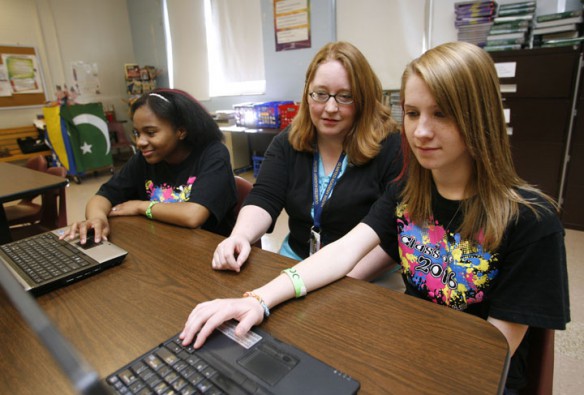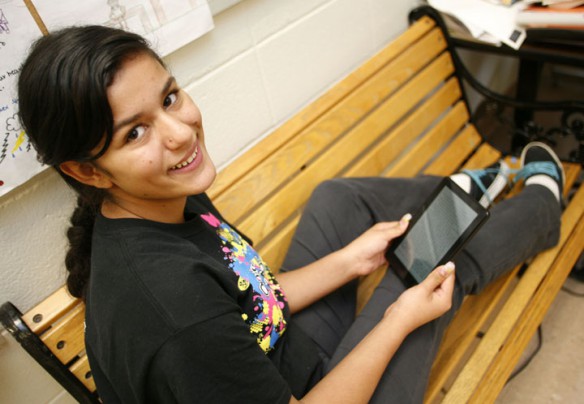
Language arts teacher Erin Yates, center, shows 8th-grade students Deja Rozier and Olivia Lenberger the websites Tween Tribune and Teen Ink for their summer reading pleasure at Fredrick Law Olmstead Academy South (Jefferson County).
By Susan Riddell
susan.riddell@education.ky.gov
Traditionally, students are sent home at the end of the school year with a summer reading list chocked full of fictional literature.
That’s something that needs to change, according to Kentucky Department of Education (KDE) literacy consultants MK Hardaway and Synthia Shelby and teachers like Erin Yates.
Both Hardaway and Shelby agree that students deserve more freedom in book selection and that other avenues for different forms of text should be embraced.
“As adults, we enjoy choosing the books we read on a daily basis,” Hardaway said. “However, when we send home booklists for the summer, it seems much more structured for students. Why? Why don’t we give them a little more freedom by providing them with books that may interest them? We should provide websites that encourage not only reading, but also questioning, analyzing, critiquing, comparing, contrasting and synthesizing ideas.”
Yates teaches 8th-grade language arts at Frederick Law Olmstead Academy South (Jefferson County). She said her school is in the process of redesigning its summer reading practices, but in the past, novels have been suggested for students to read over the summer. Students also have completed a writing assignment to reflect what they read.
“I believe (summer reading) is important if for no other reason than to encourage students to be lifetime learners,” Yates said. “I would like to see summer reading programs be more student-friendly and more fully embraced by students and schools to show them that learning doesn’t just happen inside the school building.
“Their learning and thinking goes on at night, on weekends and in the summer,” she added. “A summer reading program that promotes high interest and participation by students helps to give them support in this lifelong learning.”
Shelby suggests that teachers offer summer reading lists with several informational text components, allowing students to complement those with fictional literature and enabling students to have more ownership in what they read over the summer months. The use of informational texts is highly emphasized in the Kentucky Core Academic Standards.
“Twenty-first century learning has taken a huge turn into the land of technology and so have our students,” Shelby said. “Even though some of our students don’t have a home computer, many of them have a cell phone which they are using for Facebook, Twitter, e-mail, movies and more. We suggest harnessing this technology by giving our students websites that encourage reading on a whole new plane. The websites (see box) encourage students to not only read, but also to post reviews, write their own stories, dig deeper into a subject area that arouses their individual interests, share their reading with friends on social media outlets like Facebook and Twitter and even create their own book trailers to post on YouTube.
“Let the students choose whether they want to have a physical book or another type of reading right in the palm of their hands,” Shelby added. “If they choose it, they are more likely to read it and share it with others.”
Hardaway said that Twitter can be a great “hook” for informational reading over the summer.
“We know how engaging Twitter can be,” Hardaway said. “Users sometimes tweet three to five shocking, interesting or plain crazy facts a day. If the fact interests you, you can click a link to a short informational article on the fact. Of course, we don’t click on every one, but we can see how this could get a student to read at least one informational text a day.
“The facts are short like ‘Eating boogers is actually good for you!’ or ‘A Chinese boy was born with 11 extra fingers and toes!’ This certainly would be tempting to many students. A teacher, team of teachers or school could easily create such an account for their students.”
Yates agreed with this approach, adding that blogs and other educationally appropriate websites also bring new life to summer reading.
“It is something that I would love to see in our own reading program but also across the district,” she said. “I believe that students should still be encouraged to read novels, but to also include informational texts. By using technology students would be able to read and interact even when they are not in school. Not only would using new technologies be fun for students, it would also help them become college- and career-ready.”
Teachers can make these options available to students who don’t own computers, and there are ways to monitor completion of assignments, too, Shelby said.

Eighth-grade student Kimeta Fazliji checks out The Hunger Games on a Kindle at Fredrick Law Olmstead Academy South (Jefferson County). Her teacher, Erin Yates, recognizes students will be enjoying this summer reading on a variety of platforms. Photo by Amy Wallot, April 6, 2012
“If teachers and/or parents are worried about how to capture this information and find out if students are really reading, then teachers can create a team blog, wiki or a VoiceThread for kids that they can access from a home computer, iPad, phone or the local library,” she said. “Students and their teacher could be asked to create at least two or three responses on something that they have read during the course of the summer. It could be on the same book or on several articles. They would also be asked to respond to at least two or three other classmate’s postings.
“To ensure that all students have access to these books and non-print sources, teachers and schools could partner with the community libraries, boys and girls clubs and/or community centers,” Shelby added. “By sending the school reading lists to these institutions, students will have another avenue in which to participate.”
While Yates would like her students to have a strong mix of novels and informational text to read over the summer, she said her biggest hope is that they find a novel they truly enjoy.
“I would want them to find something that they can’t put down because they love it so much,” Yates said. “When students find a book they love, it opens the door to a love of literature.”
MORE INFO …
MK Hardaway, kay.hardaway@education.ky.gov, (502) 564-2106, ext. 4513
Synthia Shelby, synthia.shelby@education.ky.gov, (502) 564-2106, ext. 4521




Leave A Comment